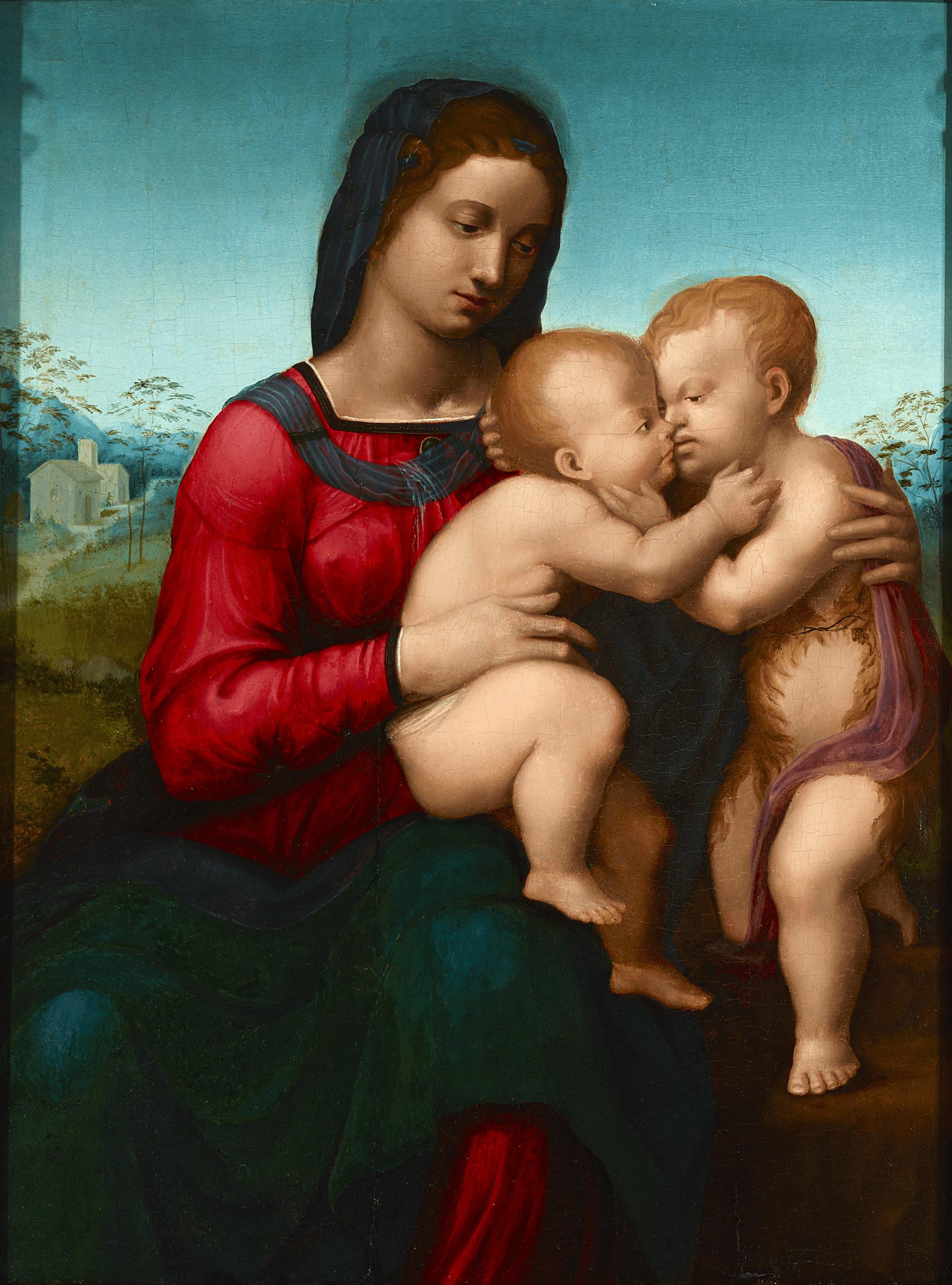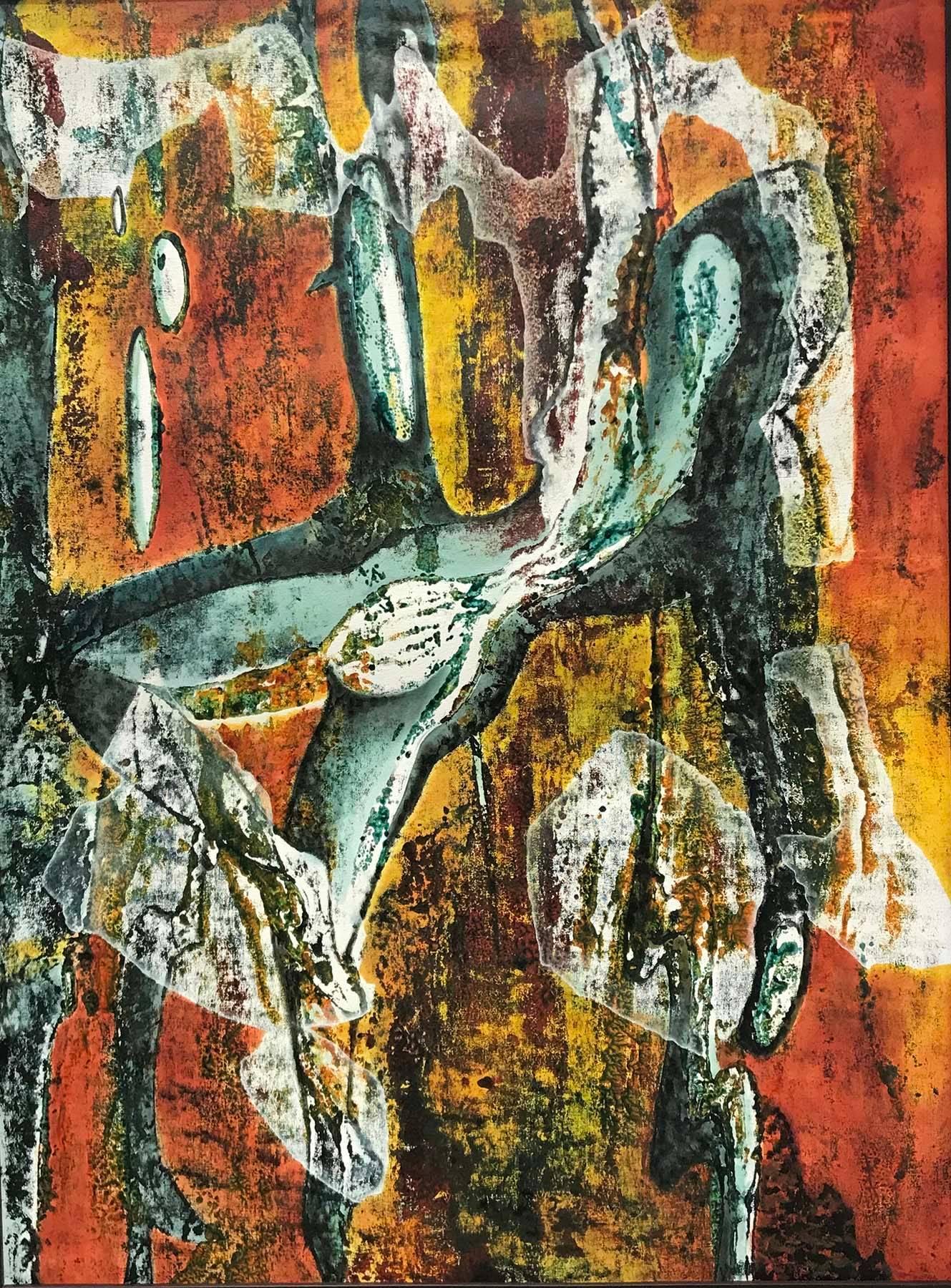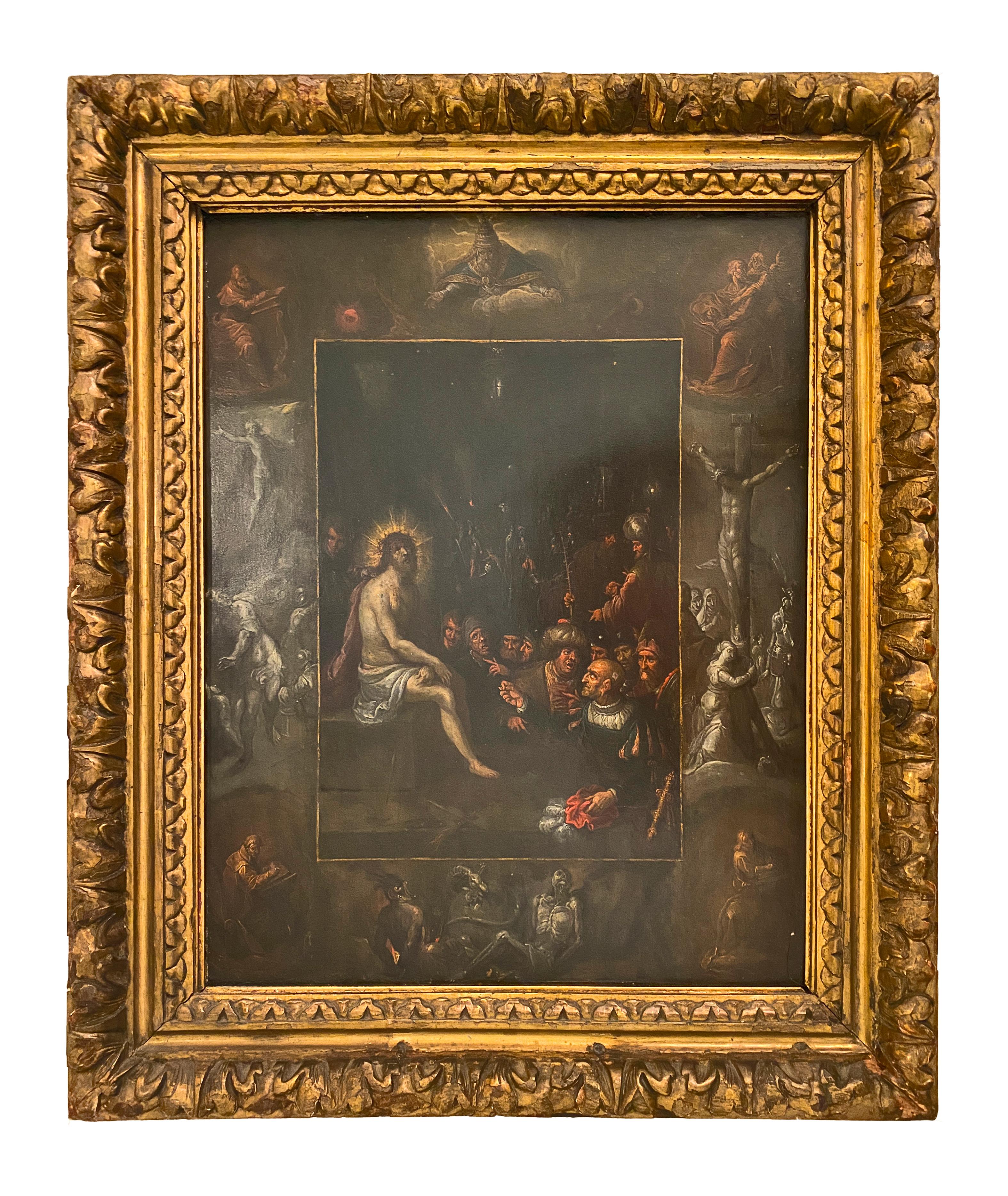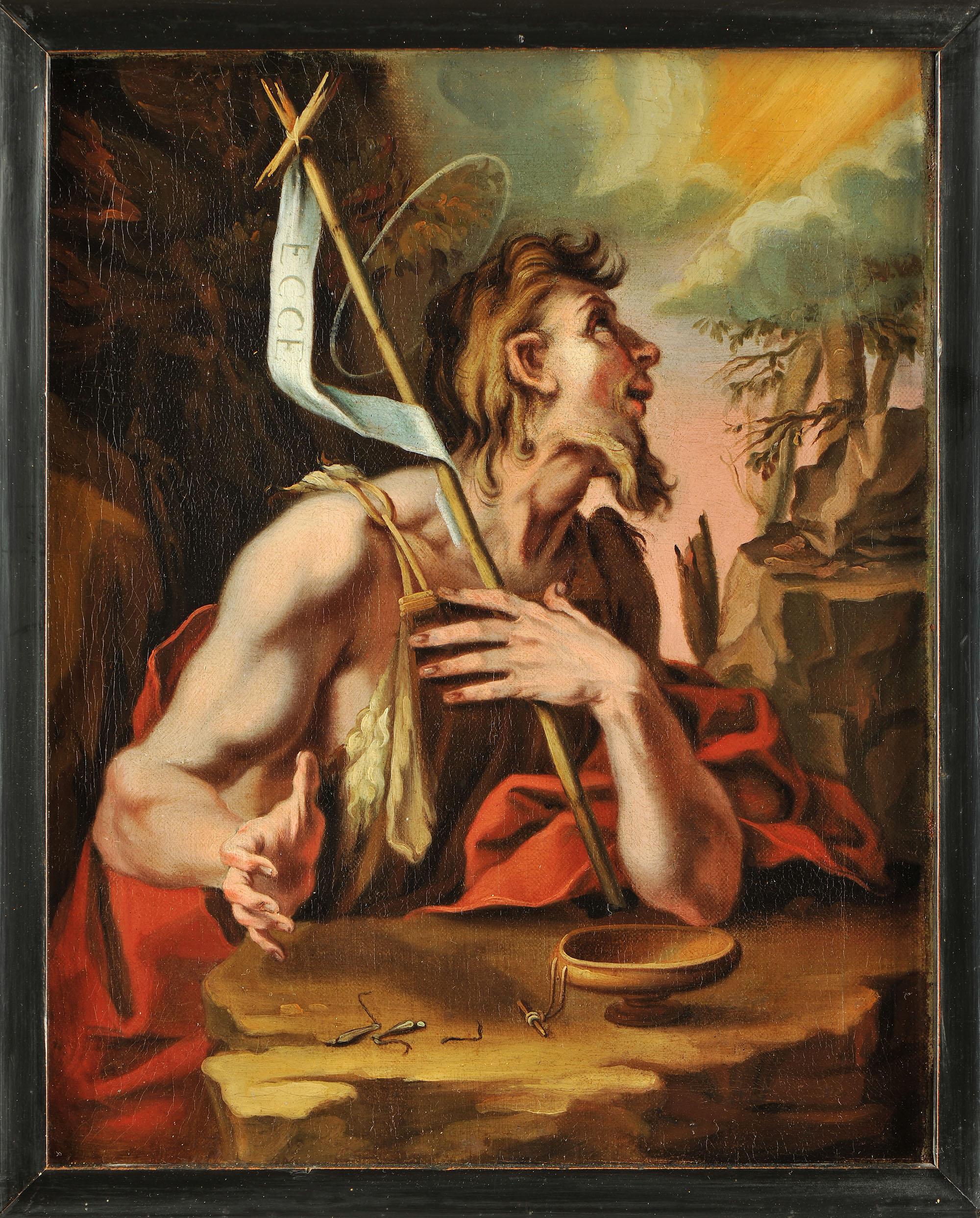Items Similar to Dipinto religioso manierista emiliano raffigurante Santa Caterina, XVI secolo
Want more images or videos?
Request additional images or videos from the seller
1 of 16
Dipinto religioso manierista emiliano raffigurante Santa Caterina, XVI secoloprima metà del XVI secolo
prima metà del XVI secolo
About the Item
The painting, of which the subject is Saint Catherine from Alexandria with the breaking wheel used for her martyrdom, can be attributed to the mannerist artist of Emilia Romagna region Luca Longhi thanks to various similarities with his works.
For example, the physiognomy of the saint-characterized by a genuine elegance-reminds of the "Cleopatra" and the "Mary Magdalene", while the hairstyle-the hair adorned with a simple wire of shiny pearls- is extremely similar to the one of "Venus" and of the saint Catherine from Siena in the "Mystic Marriage" (the four paintings aforementioned are in private collections). The sever and plain composition marked by an archaic composure and delicate and sober nuances of colors is also a typical traits of his style.
- Attributed to:Luca Longhi (1507 - 1580, Italian)
- Creation Year:prima metà del XVI secolo
- Dimensions:Height: 21.26 in (54 cm)Width: 16.93 in (43 cm)
- Medium:
- Movement & Style:
- Period:
- Condition:
- Gallery Location:Florence, IT
- Reference Number:1stDibs: LU1240213903462
About the Seller
5.0
Vetted Seller
These experienced sellers undergo a comprehensive evaluation by our team of in-house experts.
Established in 1958
1stDibs seller since 2019
23 sales on 1stDibs
Typical response time: <1 hour
- ShippingRetrieving quote...Ships From: Florence, Italy
- Return PolicyA return for this item may be initiated within 2 days of delivery.
More From This SellerView All
- Palma Giovane Atelier Religious Christ Mannerism Painting 17th century oil woodLocated in Florence, ITThe lamentation of Christ is a very common theme in christian art, where the body of Christ is an important subject of devotion. This painting was suppose to stay on an altar, highlighting the double presence of the son of God that was not only depicted but that also was present during the Eucharistic moment. It can be attributed to the Circle of Jacopo Palma il Giovane...Category
Early 17th Century Mannerist Figurative Paintings
MaterialsOil, Wood Panel
- Quattro Virtù Cardinali tempera su tela, arte manierista toscana del XVI secoloBy Cristofano RusticiLocated in Florence, ITCristofano Rustici called il Rusticone was an artist active in Siena between the 16th and 17th century, son of Lorenzo Brazzi called il Rustico (Siena 1521-1572). Even if his artistic training started in the family workshop, he was mostly very influenced by the Flemish artist Bernhard van Rantwijk, who was also living in the Tuscan town at the same time. The subject of the four paintings are the Cardinal Virtues...Category
16th Century Mannerist Figurative Paintings
MaterialsTempera, Canvas
- Italian Veneto Baroque Religious Figurative Painting 17th century oil paper woodLocated in Florence, ITThis small painting (oil on paper attached on a wood panel, 18 x 12.5) represents Saint Jerome, dressed up as a cardinal, sitting outside, in reference to his experience as a peniten...Category
Mid-17th Century Baroque Landscape Paintings
MaterialsPaper, Oil, Wood Panel
- Italian Baroque religious figurative painting of the 17th century oil on canvasLocated in Florence, ITPainted with gilt wood frame, 58 x 75 cm. is the work of the painter couple Viviano Codazzi (Valsassina 1603-Rome 1670), who specialized as a quadraturist and landscape painter, and...Category
1640s Baroque Interior Paintings
MaterialsCanvas, Oil
- G Negri called Il Boccia Baroque Figurative Painting 17th century oil canvasBy Girolamo Negri called Il BocciaLocated in Florence, ITOil on canvas, 62 x 51 cm (without the frame) Even if on the background there is an attribution to “Francesco Gessi pupil of Guido Reni” by the bolognese art historian Guido Zucchini (dated 1945), recent studies are tending to add it to the corpus of Girolamo Negri called Il Boccia (Bologna 1648-1718) due to lots of similarities with his style (the pale and warm palette chosen, the profile) The painting represents a lady on profile wearing a brown turban, a yellow clock...Category
Late 17th Century Baroque Figurative Paintings
MaterialsCanvas, Oil
- Roman Baroque Painting 17 century oil canvasLocated in Florence, ITThe painting represents the moment of the death of Lucretia, a Roman noblewoman who was raped by the seventh and last King of Rome-the Etruscan Tarquin the Proud-and committed suicide-in front of her husband and her father-because she couldn’t stand the violence she passed through. According to the legend, this episode caused the rebellion that overthrew the Roman monarchy and led to the transition of Roman government from a kingdom to a republic. The scene is entirely dominated by the figure of the lady, emerging from a dark background in contrast with the brightness of her skin and of the colors of her dress. The torments and agony are intensively expressed by her glance, capable of creating a strong empathizing. The shiny white skin and the pearls (symbol of virginity) in her hair are an allegory of her purity, while the red tablecloth seems predicting the violent end. The painting is characterized by lots of exquisite details (like the richly decorated knob of the knife, the ribbon that tie up the purple curtains...Category
Mid-17th Century Baroque Figurative Paintings
MaterialsOil, Canvas
You May Also Like
- Virgin and Child with the Infant Saint JohnBy Domenico PuligoLocated in New Orleans, LAA masterful example of Italian Mannerist painting, this exceptional panel was composed by the renowned Florentine painter Domenico Puligo. Alongside Jacopo Pontormo and Rosso Fiorentino, Puligo is remembered as one of the foremost figures of the Mannerist movement that rose to prominence during the 16th century in Florence. This panel of the Virgin Mary with the Christ child and Saint John the Baptist is a characteristic example of his celebrated devotional images, which grace museums such as the Metropolitan Museum of Art (New York), Museo del Prado (Madrid), Palazzo Borghese (Rome), and Palazzo Pitti (Florence), among many others. Puligo’s skill with color is fully demonstrated in the beautifully preserved work. Considering its age, the vibrancy and the sheer range of color is remarkable. The Virgin Mary’s crimson dress...Category
16th Century Mannerist Portrait Paintings
MaterialsOil, Panel
- DanceBy Lorena VillalobosLocated in Los Angeles, CALORENA VILLALOBOS "DANCE" OIL ON CANVAS, SIGNED COSTA RICA, DATED 2005 39 X 29 INCHES Lorena Villalobos Villalobos was born in Costa Rica in 1961. She studied Fine Arts at t...Category
Early 2000s Mannerist Figurative Paintings
MaterialsCanvas, Oil
- Amor Cutting Bow, Parmigianino, Old Master, Mannerism, Prague, Large PaintingLocated in Greven, DEAlready in the collection of Emperor Rudolf II in the first decade of the 17th century this composition was famous. The original is by Parmigianino and Rudolf's court painter Joseph Heintz...Category
17th Century Mannerist Figurative Paintings
MaterialsCanvas, Oil
- Mocking of Christ, by Frans Francken (II) and possibly Ambrosius Francken (II)By Frans Francken IILocated in Brooklyn, NYMocking of Christ, with all around in grisaille: the Crucifixion, the Resurrection, God the Father, Mankind after the Fall,; in the corners the four evangelists. J. Dijkstra ao, cat. The paintings of Museum Catharijneconvent, Utrecht (Museum Catharijneconvent) 2002, p. 196, pict., as Frans Francken...Category
17th Century Mannerist Figurative Paintings
MaterialsCopper
- Fenzoni, Painting AND preparatorial Drawing, John the Baptist, Italy RenaissanceBy Ferrau FenzoniLocated in Greven, DEThe painting and the preparatory drawing are offered together. Provenance Private collection, Germany, Trier, c. 1980- 2013 Saint John the Baptist Brown ink and wash over red chalk on oatmeal paper 31 x 20.5 cm Inscribed: „Ferrau Fenzonio da Faenza invt. esque … imp. da Fran. Villamena …“. bears the collector's mark of Henry Scipio Reitlinger (1882-1950; Lugt 2274a) on a tiny label glued to the verso On the reverse is a partial drawing of a Pieta, pricked for transfer. Provenance New York, Doyle, 14. October 2015, No. 6 The painting and the preparatory drawing resemble the composition of an engraving after Ferraù Fenzoni by Francesco Villamena. Drawing, engraving and painting are almost identical, except for minor differences. Even the measurements nearly correspond: painting (32 x 25,5 cm), drawing (30 x 20,5 cm), engraving (31,1 x 23,5 cm). Dr. Guiseppe Scavizzi confirmed the attribution of the present panting to Fenzoni and he dates it to c. 1590. The inscription on the drawing reads “Ferrau Fenzonio da Faenza invt. esque. . . imp. da Fran: Villamena . . .”. The engraving’s inscription also lists place and date “Ferra Fensionius inventor/F. Villamoena sculpsit Rome/Aspectu fruitur… antra puer/cum Privilegio… 1613”. Interestingly, the engraving is not mirrored as it is in most printing processes. Painting, drawing and engraving are not reversed but the same. It is remarkable to note that there are further paintings by Fenzoni which were engraved in the same order and not reverted. They also show strong parallels regarding the compositions and the measurements (see for example “Deposition of Christ” ). Ferraù Fenzoni was an Italian painter mainly active in Todi. He is also called Il Faenzone after his birthplace (Faenza). He apprenticed in Rome during the papacy of Gregory XIII and contributed to numerous fresco cycles under pope Sixtus V, such as the Loggia della Benedizioni in the Lateran Palace, the frescoes on the walls and vaults of the Scala Santa of the adjacent Basilica of San Giovanni in Laterano, and the decoration in the Sistine library. His expressive canvases straddle the styles of Mannerism and Baroque. In 1594, he moved to Todi. A “Last Judgement” by him is housed in the cathedral of Todi. He returned to Faenza in 1599, where he decorated chapels in the cathedral from 1612 to 1616. In 1622, he completed a “Deposition”, now in the local Pinacoteca. In 1640, Fenzoni was named “cavaliere dello speron d’oro” by Cardinal Colonna and, on 25th April 1634, he was nominated vicar and “castellano of Granarolo”. Fenzoni‘s style is characterized by a mixture of the Mannerism of the Northern Netherlands and the Italian Baroque. Saint John the Baptist, Old Master, 17th Century, By Fenzoni, Religious Scene, Rome Art...Category
16th Century Mannerist Figurative Paintings
MaterialsCanvas, Oil, Handmade Paper
- 17th C Portrait of Russian Nobleman wearing Ushanka Hat, Flemish Shool.By David Teniers the YoungerLocated in brussel, BEThe portrait represents a man, estimated to be 60 years of age, standing turned to the viewer's right, looking at the viewer with a commanding expression. He has a moustache and beard and wears a high fur cap. He wears a brown mantle over a whitish shirt and, over it, a heavy gold chain...Category
17th Century Baroque Portrait Paintings
MaterialsOil, Wood Panel





